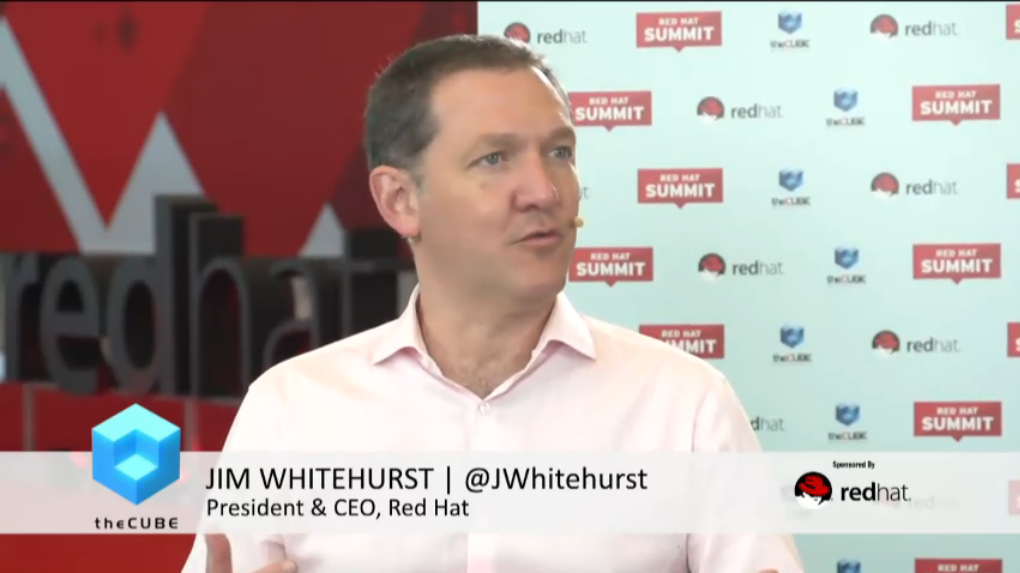 CLOUD
CLOUD
 CLOUD
CLOUD
 CLOUD
CLOUD
Red Hat Inc. just hit a rough patch, and it may take the open-source enterprise software bellwether at least another quarter to dig its way out.
That’s the upshot of third-quarter earnings reported today. Revenues for the quarter ended Nov. 30 came in below analysts’ estimates, and the company’s fourth-quarter outlook also missed expectations. As a result, the Linux software giant saw its shares plunge up to 13 percent in after-hours trading today, to about $70 a share.
The company reported a net profit of $68 million, or 37 cents a share, on revenues of $615.3 million. After adjustments for stock-based compensation and other costs, Red Hat earned 61 cents a share. Analysts polled by FactSet had forecast the company would earn 58 cents a share on sales of $619 million.
Several problems caused the revenue shortfall. For one, the strengthening dollar hurt revenues by about $16 million in the quarter. Also, two large deals with the federal government failed to close in the third quarter because of delays in completing the federal budget. Those, which would have added up to $27 million in revenues and off-balance sheet sales backlog, are expected to close in the fourth quarter.
More broadly, though, Red Hat saw more large deals over several years, which is usually a good thing. Indeed, all of the 30 top deals were $2 million or more for the first time. Three were over $10 million, two over $20 million. And the company logged 73 deals over $1 million, up 20 percent from a year ago.
But the way customers pay for the largest deals had a bigger short-term impact than the company had expected. For one thing, customers on several large multi-year contracts paid upfront for only the first year, which meant less revenue from them in the short term.
Although customers are committed to pay over the entire contract period, they’ve become accustomed to pay-as-you-go deals such as those they have with public cloud providers such as Amazon Web Services and Microsoft Azure. So that’s how they want to pay Red Hat as well, a change from smaller deals for which customers pay the entire amount upfront, the way they traditionally paid for software licenses. Red Hat’s Linux software runs on computer servers in corporate data centers, but it’s looking to get more traction in hybrid cloud computing setups where customers use both the public cloud and private data centers.
What’s more, the company said it was suffering from a tendency that began in the second quarter for deals to close in the last month or even week of the quarter, making it difficult to make accurate forecasts and sometimes pushing deals to the next quarter. Chief Financial Officer Frank Calderoni said the company is working to improve “linearity” of deals throughout each quarter, partly by compensation sales managers to avoid last-minute deals. but he didn’t offer a specific time when those efforts would be successful.
Not least, investors also may be wary of the announcement today that Calderoni is leaving to take a chief executive job at an unnamed company. Eric Shander, vice president of finance and accounting and principal accounting officer, will take over as acting CFO.
Chief Executive Jim Whitehurst (above) said on the earnings conference call with analysts that he’s “confident we will see a reacceleration of billings” in the fourth quarter. “Our overall business is stronger than would appear in the short-term,” he said.
But while the two federal mega-deals are expected to close in the fourth quarter, Red Hat forecast fourth-quarter revenues of $614 million to $622 million and full-year revenues of $2.397 billion to $2.405 billion. Those were both under analysts’ expectations as well.
Still, analysts on the call hammered Red Hat executives on the various reasons for the shortfalls, attempting to dig out any deeper reasons for the negative surprise — particularly on the impact from customers moving to large public clouds. The company, Global Equities Research analyst Trip Chowdhry said in a note to clients today, “will continue to lose its relevance as the customer progresses in its journey to SuperClouds” such as AWS and Azure.
Whitehurst insisted the problems were not with the company’s fundamental business. “Overall we remain optimistic about the long-term growth prospects for the company,” he said. As for the greater end-of-quarter deals, Whitehurst conceded that “with large deals, buyers are programmed in the last week because they believe they’ll get better deals. I don’t think there’s any systemic [problem] with the business.”
One analyst agreed. “Red Hat comments about delays in deal signing in November mirrored Workday’s and Oracle’s comments and could very well indicate a broader industry dynamic,” Raimo Lenschow, an analyst with Barclays, said in a note to clients. “We believe the company continues to be well positioned to benefit from the structural shift from proprietary software to open source and from on-premise to cloud based workloads.”
Whitehurst spoke to theCUBE, SiliconANGLE’s mobile livestreaming unit, at the Red Hat Summit in June:
(Disclosure: TheCUBE was a paid media partner at the conference. Neither Red Hat nor other sponsors have editorial influence on content on theCUBE or SiliconANGLE.)
THANK YOU